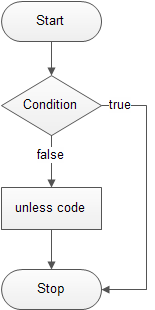Summary: in this tutorial, you’ll learn about the Perl unless statement that executes a code block when a condition is false.
Introduction to Perl unless statement
Before discussing the unless statement, let’s revisit Perl’s philosophy: there is more than one way to do it.
Perl always provides you with an alternative way to achieve what you need to do.
For example, Perl has the if statement that allows you to control the execution of a code block conditionally.
It also provides the unless statement that is similar to the if statement.
In programming, you often hear something like this:
- If it’s not true, then do this (use
ifnot statement). - or unless it’s true, then do this (use
unlessstatement).
The effect is the same but the philosophy is different. That’s why Perl invented the unless statement to increase the readability of code when you use it properly.
Note that the Perl unless statement is equivalent to the if not statement.
Perl unless statements
Let’s some examples of using the unless statement.
1) Simple Perl unless statement
The following illustrates the simple Perl unless statement:
statement unless(condition);Perl executes the statement from right to left, if the condition is false, Perl executes the statement that precedes the unless. If the condition is true, Perl skips the statement.
If you have more than one statement to execute, you can use the following form of the Perl unless statement:
unless(condition){
// code block
}Code language: Perl (perl)If the condition evaluates to false, Perl executes the code block, otherwise, it skips the code block.
The following flowchart illustrates the Perl unless statement:

See the following example:
my $a = 10;
unless($a <= 0){
print("a is greater than 0\n")
}Code language: Perl (perl)2) Perl unless…else statement
Sometimes you want to say unless the condition is true, then do this, otherwise do that.
This is where the unless...else statement comes into play. See the following unless else statement:
unless(condition){
// unless code block
}else{
// else code block
}Code language: Perl (perl)If the condition is false, Perl will execute the unless code block, otherwise, Perl will execute the else code block.
my $a = 10;
unless($a >= 0){
print("a is less than 0\n");
}else{
print("a is greater than or equal 0\n");
}Code language: Perl (perl)The output of the code above is as follows:
a is greater than or equal 03) Perl unless..elsif…else statement
If you have more than one condition for checking with the unless statement, you can use the unless elsif else statement as follows:
unless(condition_1){
// unless code block
}elsif(condition_2){
// elsif code block
}else{
// else code block
}Code language: Perl (perl)You can have many elsif clauses in the unless elsif statement. See the following example:
my $a = 1;
unless($a > 0){
print("a is less than 0\n");
}elsif($a == 0){
print("a is 0\n");
}else{
print("a is greater than 0\n");
}Code language: PHP (php)What is the output of the code? As you see, it is getting more complicated even with simple conditions.
Perl unless statement guidelines
You should use the unless statement with a simple condition to improve the code readability, especially when used as a postfix after another statement like the following example:
my $a = 1;
print("Perl unless used with a very simple condition ONLY.\n") unless($a < 0);Code language: Perl (perl)You should avoid using the unless statement when the condition is complex and requires else and/or elsif clauses.
If you take a look at the following code, it is difficult to interpret the meaning of the condition.
my $a = 1;
my $b = 10;
my $c = 20;
unless($a < 0 && $b == 10 && $c > 0){
print("unless used with a very complex condition\n");
}Code language: Perl (perl)In this tutorial, you have learned the Perl unless statement, which is equivalent to the if not statement, that allows you to control the flow of code conditionally.